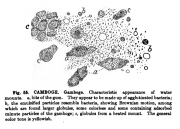Garcinia hanburyi (gum resin)
Contents |
Introduction
Introduction from Wikipedia, the free encyclopedia (http://en.wikipedia.org/wiki/Garcinia_hanburyi and http://en.wikipedia.org/wiki/Garcinia, retrieved 02/27/2012).
Garcinia is a plant genus of the family Clusiaceae native to Asia, Australia, tropical and southern Africa, and Polynesia. The number of species is highly disputed, with various sources recognizing between 50 and about 300 taxa as specifically valid. Commonly, the plants in this genus are called saptrees, mangosteens (which may also refer specifically to the purple mangosteen, G. mangostana), garcinias or, ambiguously, "monkey fruit".
Garcinia species are evergreen trees and shrubs, dioecious and in several cases apomictic.
Garcinia hanburyi is a plant species in the genus Garcinia the gamboge trees. It is referred to in English variously as Hanbury's Garcinia, Gambojia, Gamboge, Indian Gamboge tree, in Indian as Tamāla (तमाल) or Tamal, and as Gummi-gutti in German.
The quoted text in this section was licensed for use under the Creative Commons ShareAlike License, version 3.0: http://creativecommons.org/licenses/by-sa/3.0/
Macroscopic Entries
Microscopic Entries
|
HPTLC Entries
Other Points of Interest
Cite error: <ref> tags exist, but no <references/> tag was found
